Endocrine system
1/32
There's no tags or description
Looks like no tags are added yet.
Name | Mastery | Learn | Test | Matching | Spaced |
|---|
No study sessions yet.
33 Terms
Comparison of endocrine and nervous system
Characteristic | Nervous system | Endocrine system |
Nature of message | Electrical impulses and neurotransmitters
| Hormones |
Transport of message | Along the membrane of neurons
| By the bloodstream |
Cells affected | Muscle and gland cells; other neurons
| All body cells |
Type of response | Usually local and specific | May be general and widespread |
Time taken to respond | Rapid – within milliseconds
| Slower – seconds to days |
Duration of response | Brief – stops quickly when stimulus stops. | Long lasting – may continue long after stimulus has stopped |
Endocrine system
Influences cell activity by releasing chemical messengers – hormones
Homeostasis
The maintenance of a relatively constant internal environment despite fluctuations in the external environment. The composition and temperature of the fluids around cells. Achieved through dynamic equilibrium – fluctuations around an ideal or optimal state.
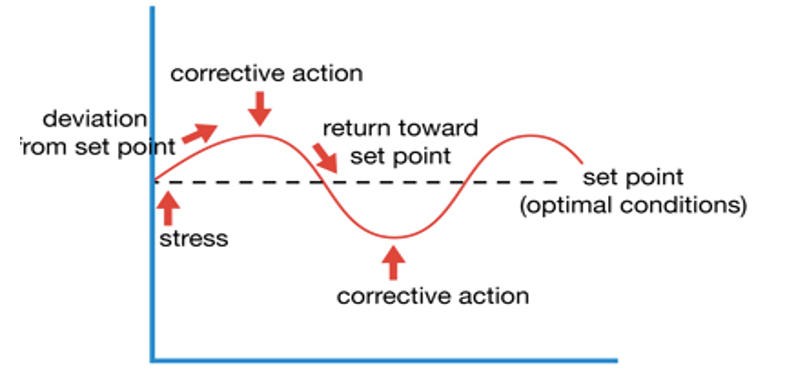
Tolerance limits
The upper and lower conditions in which the body can function normally. Dysfunction will occur if the conditions fall outside these limits. The tolerance limit for body temperature is 36.5 – 37.5oC.
Exocrine glands
Secrete into a duct that carries secretion to the body or to the body cavities. Target sites of the gland are located close to the exocrine gland. E.g. Sweat, mucous, salivary.
Endocrine glands
Secrete hormones into extracellular fluid surrounding cells that make up the gland. Usually passes into capillaries and transported into blood. target sites of the are far from the gland. E.g. Thyroid, parathyroid, adrenal.
Hormones
Chemicals, secreted by endocrine glands, transported throughout the body in the blood. They alter the functioning of cells by changing the type, activities or quantities proteins produced. May:
-Activate certain genes in the nucleus so a particular enzyme or protein is produced.
-Change the shape or structure of an enzyme so it is turned on or off.
-Change the rate of enzyme or protein production by changing rate of transcription or translation during protein production
May be steroids, proteins or amines.
What can hormones influence?
Can only influence cells with the correct hormone receptor. Thus, hormones may affect all body cells or only particular groups of cells – Target cells.
Different cells have different types and numbers of receptor proteins. Only on particular organs – Target organs.
Steroid hormones
Examples | Solubility | Time of Effect | Process |
Oestrogen | Lipid-soluble
Does NOT dissolve in water | Slow to take effect.
Long lasting | 1) Once released into blood, the hormones bind to transport proteins, allowing them to travel in blood stream. |
Progesterone | 2) When they reach target cells, the hormones separate from the transport protein and diffuse across the cell membrane. | ||
Cortisol | 3) Inside the cell, they combine with a receptor protein in cytoplasm or nucleus. | ||
Aldosterone | 4) Hormone-receptor complex activates the genes controlling formation of particular proteins by binding to the promoter section of a gene, stimulating or inhibiting transcription and protein synthesis. |

Protein and amine hormones
Amine hormones are synthesized from the amino acids tryptophan or tyrosine. Composed of an amino acid with a modified group.
Protein hormones are those consisting of a long chain of amino acids (a protein).
Examples | Solubility | Time of Effect | Process |
Prolactin (P) | Water-soluble
| Quick to take effect
| 1) As they cannot diffuse across the cell membrane, they attach to receptor proteins in the membrane of the target cell. |
Growth hormone(P) | |||
Melatonin (a) | Unable to cross the cell membrane (not lipid-soluble) | Short- lasting effect | 2) The combination of the hormone with the receptor causes a secondary messenger substance to diffuse through the cell and activate particular enzymes. |
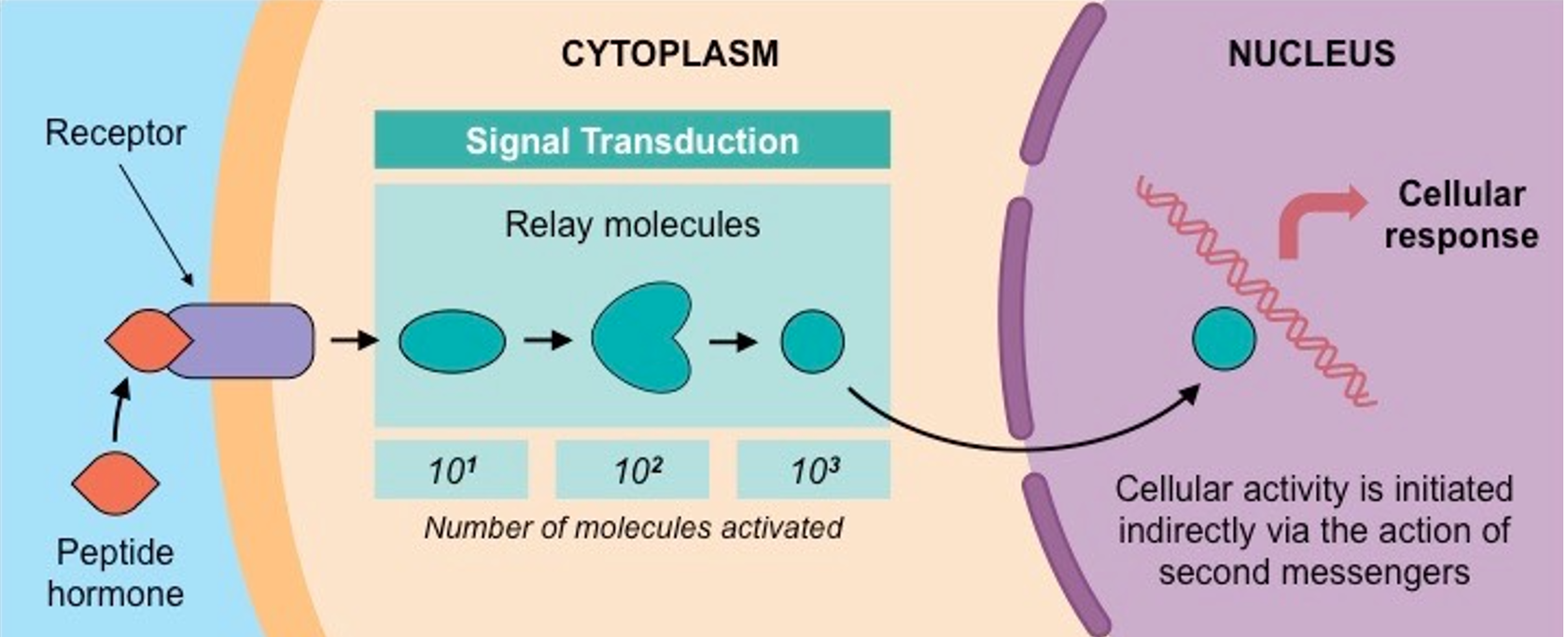
Hormone receptors
Receptor proteins are specific. Each receptor type will bind with only 1 specific molecule.Limited number of receptor proteins in membrane of cell. When each receptor is bound to a molecule, there can be no further increase in the rate of the activity (saturated). Different cells have different types and numbers of receptor proteins. Variation in sensitivities of cells to hormones.
Enzyme amplification
Causes the activation of thousands of enzyme molecules. The hormone triggers a cascading effect where the number of reacting molecules involved is increased 100-1000x for each stop along the metabolic pathway. One hormone could trigger the production of over a billion enzyme molecules. A small stimulus can have a large effect.
Hormone clearance
Once a hormone has produced the effect, it is turned off by breaking down the hormone molecules. Some are broken down in the target cells. Most are broken down in the liver and kidneys. The degraded hormones are excreted in bile or urine.
Control of hormone secretions.
To maintain homeostasis, the amount of hormone produced by an endocrine gland must be closely regulated. Over secretion or under secretion causes abnormal body functioning. Hormones are regulated by a negative feedback system where the response produced by the secretion of the hormones is the opposite of the stimulus that caused the secretion.
Hypothalamus
Connector between nervous and endocrine systems. Regulates many basic bodily functions: Body temperature, water balance, heart rate, increase or decrease secretions of glands etc. Many of its functions are carried out through the pituitary gland.
Hypothalamus processes
Hypothalamus secretes releasing factors, stimulating hormone secretion, or inhibiting factors, which slows secretion.
These factors travel through blood vessels to the anterior lobe of the pituitary gland, affecting secretion. Other hormones produced by the hypothalamus pass along the nerve fibres to the posterior lobe of the pituitary gland where they are released.
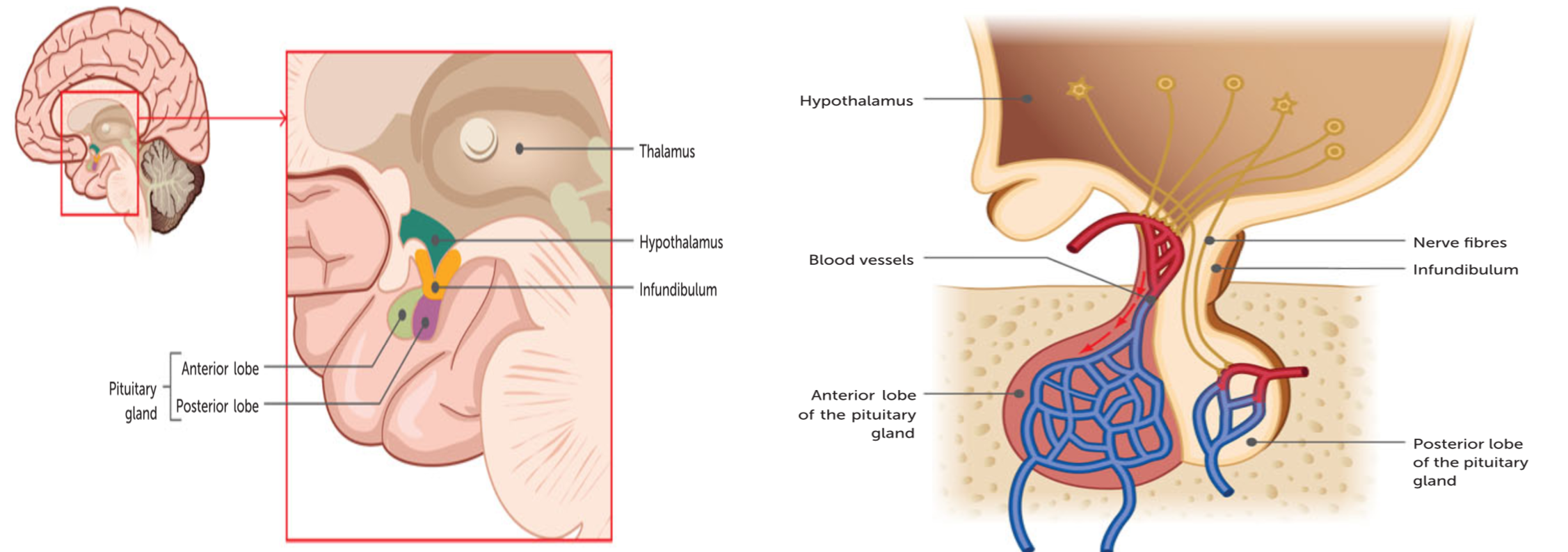
Pituitary gland
Lies under the hypothalamus by a stalk- infundibulum.
Consists of an anterior and posterior lobe which functions separately.
Not a true endocrine gland as it doesn’t secrete substances, but stores and releases hormones.
Feature | Anterior lobe | Posterior Lobe |
Size | 75% of the pituitary gland | 25% of the pituitary gland |
Where hormones are produced | the six hormones are produced in the anterior pituitary
| the two hormones are produced in special nerve cells in the hypothalamus and then stored in the posterior pituitary. |
How the release of hormones is controlled | Controls the release of hormones with hormones (releasing factors) from the hypothalamus. | Controls the release of hormones by nerve impulse initiated in the hypothalamus |
Connection to the hypothalamus | Connected to hypothalamus by a complex network of blood vessels lying in the infundibulum | joined to the hypothalamus by nerve fibres that come from nerve cell bodies in the hypothalamus and pass through the infundibulum to |
Anterior lobe of pituitary gland
Hormone | Target Organ | Main Effects |
Follicle stimulating hormone (FSH) | Ovaries (female) | Growth of follicles. Production of sperm. |
Luteinising hormone (LH) | Ovaries (female) Testes (male) | Ovulation and maintenance of corpus luteum. Secretion of testosterone. |
Growth hormone (GH) | All cells | Growth and proteins synthesis |
Thyroid-stimulating hormone (TSH) | Thyroid gland | Secretion of hormones from the thyroid |
Adrenocorticotropic hormone (ACTH) | Adrenal cortex | Secretion of hormones from the adrenal cortex |
Prolactin (PRL) | Mammary glands | Milk production |
Posterior lobe of pituitary gland
Hormones are not manufactured here, but are produced in special nerve cells in hypothalamus. Cells have long extensions that pass-through infundibulum to posterior lobe. Hormones manufactured move down the extensions and are stored for release. The release of the hormones is triggered by nerve impulses in the hypothalamus and conducted along the cell extensions.
Hormone | Target Organ | Main Effects |
Antidiuretic hormone (ADH) | Kidneys | Reabsorption of water |
Oxytocin (OT) | Uterus Mammary glands | Contractions of uterus during childbirth Release of milk |

Pineal gland
Location: Found deep inside the brain.
Function: Known that it secretes the hormone melatonin, involved in the regulation of sleep patterns. Production of melatonin is stimulated by darkness and inhibited by light.

Thyroid gland location and structure
In the neck, below the larynx
Consists of two lobes that lie on either side of the trachea and are joined by a narrow piece of tissue that lies across the front of the trachea.
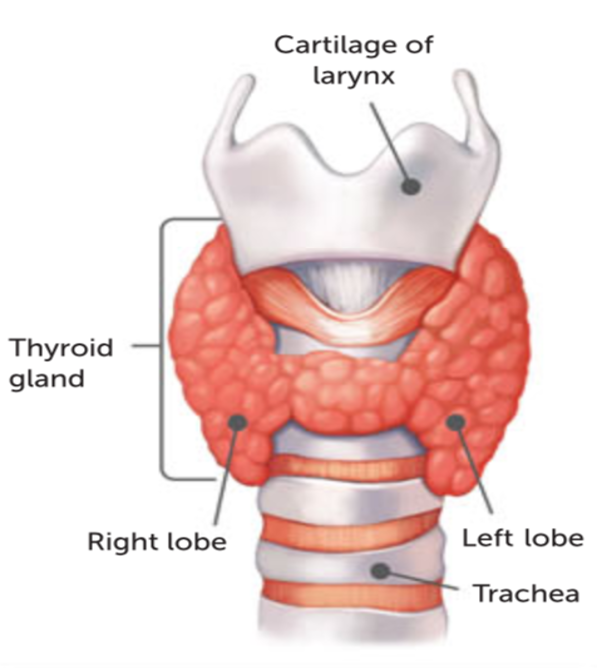
Thyroid gland function
1) The follicular cells in the gland secretes two hormones in response to thyroid stimulating hormone: thyroxine (t4, 4 iodine , less active but lasts longer.) and triiodothyroxine (T3, 3 iodine . Produced around 80%).T
2)Once released, enzymes convert T4 into T3.
3) Thyroxine controls body metabolism by regulating reactions where complex molecules are broken down to release energy, or are synthesised from simple ones.
4) Brings about the release of energy and, because some energy is in the form of heat, maintain body temperature.
Thyroid gland function - calcium and phosphate
Helps regulate this in the blood through the release of calcitonin by C-cells. When calcium in the blood increases, the gland releases calcitonin reducing reabsorption of calcium by the kidneys and the breakdown of bone. If phosphate concentration is too high, calcitonin moves phosphate into bone reducing reabsorption in the kidneys.
Parathyroid glands
In the rear surface of the lobes of the thyroid gland. Usually 4 of these, the size of a small pea.
Secretes parathyroid hormone (PTH) which increases calcium levels in the blood and phosphate excretion in the urine
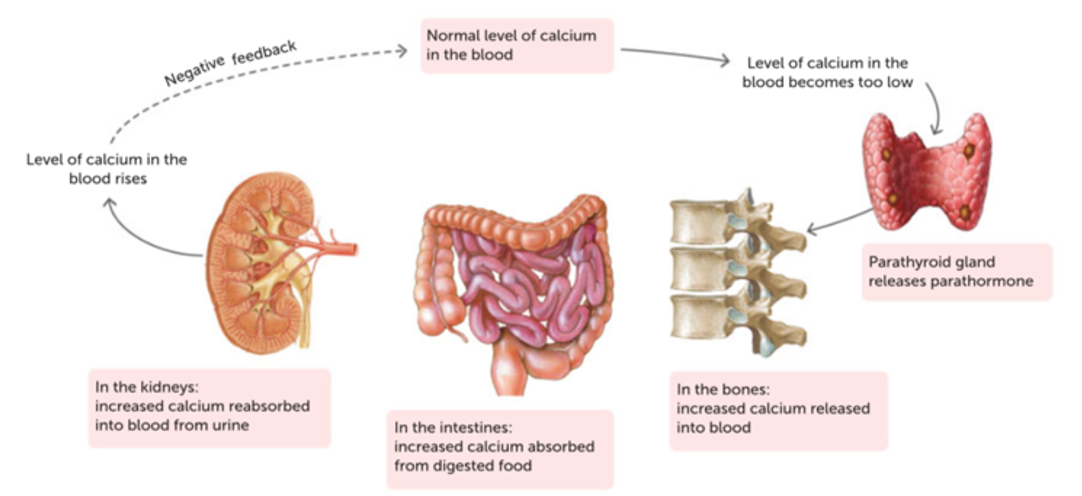
Thymus
In the chest above the heart and behind the sternum. Secretes a group of hormones called thymosins. Influences the maturation of disease fighting cells – T-lymphocytes.
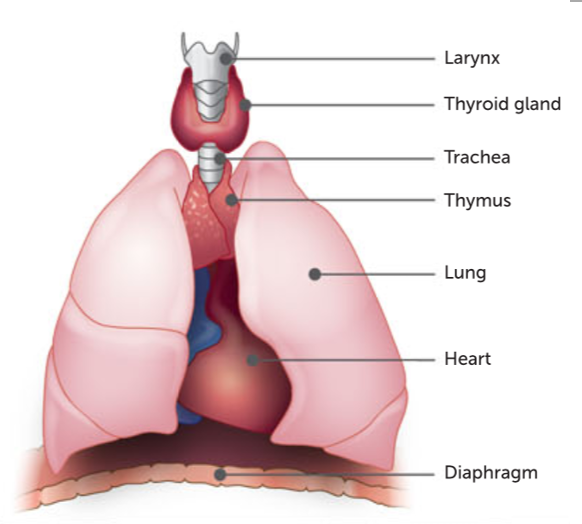
Adrenal glands
Immediately above each kidney. 2 total. Each with an inner adrenal medulla and an outer adrenal cortex. Both parts have a different structure and function.
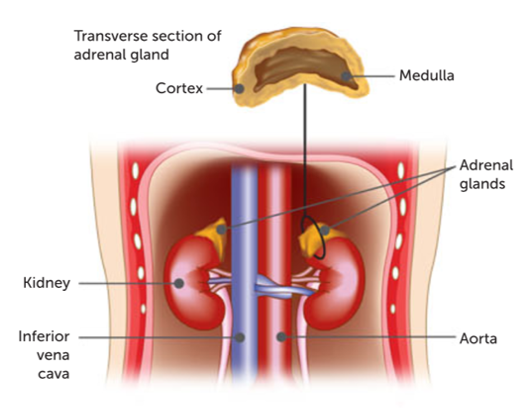
Adrenal medulla
Produces adrenaline and noradrenaline.
Adrenaline helps prepare the body for a reaction to a threatening situation. Fight or flight response. Noradrenaline increases the rate and force of heartbeat

Adrenal cortex
Produces over 20 hormones known as corticosteroids. Two main ones:
Aldosterone: Acts on the kidney to reduce the amount of sodium and increase the amount of potassium in the urine.
Cortisol: With related hormones, promotes normal metabolism, helping the body withstand stress and repair damaged tissues.
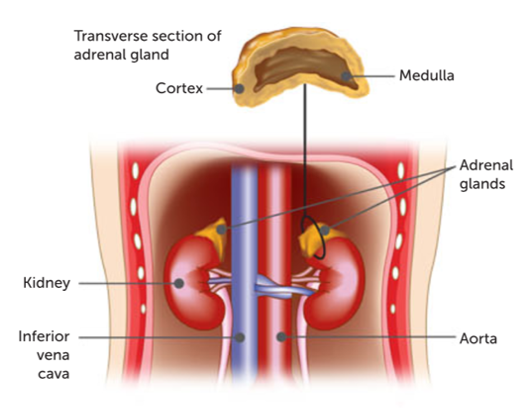
Pancreas
Soft organ around 15cm long. Below the stomach and alongside duodenum. Both an endocrine and exocrine gland. Exocrine part secretes digestive enzymes into the small intestine through pancreatic duct. Endocrine part is made of clusters of specialised cells – islets of Langerhans / pancreatic islets. These secrete:
Insulin – by beta cells of pancreatic islets.
Glucagon – by alpha cells of pancreatic islets.
Pancreas: Insulin function
-Reduces glucose in the blood (sugar) by promoting the uptake of glucose from the blood by the cells of the body.
-In the liver, causes the conversion of glucose to glycogen and fat.
-In skeletal muscles causes conversion of glucose to glycogen
-In fat storage tissue converts glucose to fat.
Pancreas: Glucagon
Acts in opposite way to insulin – increases blood glucose level
Promotes the breakdown of glycogen to glucose in the liver.
Stimulates the breakdown of fat in the liver and fat storage tissues.
Gonads
Androgens: Male sex hormones.
-Responsible for development and maintenance of male sex characteristics.
-In males, produced by the testes.
- In females, produced in the ovaries, adrenal glands and fat cells.
Oestrogen and progesterone: Female sex hormones.
-Responsible for development and maintenance of female sex characteristics.
-Produced by the ovaries
-Together with gonadotropic hormones of pituitary, they regulate the menstrual cycle and are involved in changes occurring during pregnancy.
Table of hormones
Gland | Hormone | Target cells | Main effects |
Thyroid | Thyroxin and triiodothyronine Calcitonin | Most body cells
Bones, kidney | Increase metabolic rate and thus oxygen consumption and heat production. Lower blood calcium and phosphate levels . |
Parathyroid | Parathyroid hormone | Bones, Kidneys | Increase calcium level in blood |
Thymus | Thymosins | T-lymphocytes | Stimulates development and maturation of T-lymphocytes. |
Adrenal cortex | Corticosteroids: Aldosterone
Cortisol |
Kidneys
Most body cells | Increase reabsorption of sodium ions and excretion of potassium ions.
Promotes normal metabolism; helps body deal with stress; promotes repair of damaged tissue. |
Adrenal medulla | Adrenaline and noradrenaline | Most body tissues | Prepares body for flight or flight responses; reinforces the effects of sympathetic nerve system. |
Pancreas | Insulin
Glucagon | Most body cells
Liver and fat storage tissues. | Stimulates uptake of glucose; lowers blood glucose level. Stimulates breakdown of glycogen and fat; increases blood glucose level. |
Testes | Androgens: | Many tissues | Stimulate sperm production, skeleton and muscle growth, development of male sexual characteristics. |
Ovaries | Oestrogens
Progesterone | Many tissues
Uterus and mammary glands | Stimulates development of female sexual characteristics; regulate the menstrual cycle. Regulates menstrual cycle and pregnancy; preps mammary glands for milk secretion. |